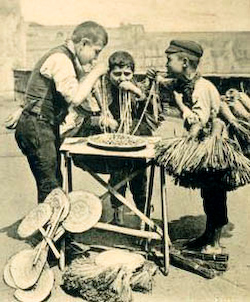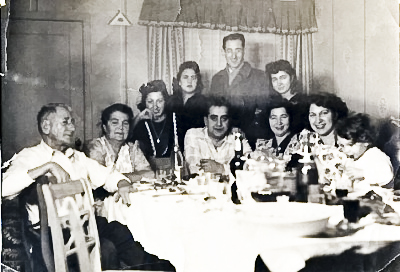
Sharing Pasta in Naples.
In 1912, three Sicilian immigrants—Michele Cantella, Gaetano LaMarca, and Giuseppe Seminara—recognized the growing demand for semolina pasta and founded the Prince Macaroni Company, naming it not for deposed Sicilian nobility, but for their location on Prince Street, in the very heart of Boston’s North End. Three years later, Emanuele Ronzoni started the Ronzoni Macaroni Company in New York.
Another Sicilian, Vincente Taormina, who had begun importing foods to New Orleans in 1905, moved to New York in 1927 to join forces with his cousin and fellow importer, Giuseppe Uddo. They called their new enterprise Progresso Foods. After the company had relocated to Vineland, N.J., the cousins changed their focus from importing Italian ingredients to producing the foods that Italian-Americans had grown accustomed to eating.
Meanwhile, other Italian entrepreneurs were filling niche markets in nearly all food-related areas of the new Italian-American culture. Commercial prosciutto-curing operations, as well as sausage and cheese-making companies, flourished in New York and New Jersey. Small Italian businesses grew into large-scale importers, bringing Parmesan, olive oil, and wine in straw-covered bottles from Italy to eager buyers in the numerous Little Italy communities.
Before long, there was an alimentaria, Italian grocery store, on nearly every block of every street in every Little Italy. For example, in the small industrial city of Middletown, Connecticut, my great-grandparents, Antonio and Sebastiana Amenta from Melilli, Sicily, opened a grocery store in their house. Patronized by fellow Melillese from all parts of town, the shop thrived and served Middletown and surrounding areas for decades.
Despite having come to America from impoverished agricultural areas, where most had not even been able to own the land they had cultivated, the new immigrants were skilled farmers. They were quick to plant a variety of vegetables and herbs in every arable space—from window boxes to back yards, community plots, and even on tenement rooftops. Along with their beloved tomatoes, basil, and chili peppers, they introduced new vegetables like arugula, zucchini, fennel, broccoli, and escarole.
Pioneers of the American wine industry, Italians had found their way to northern California’s Napa and Sonoma valleys by the 1880’s. Genoa-born Andrea Sbarbaro started the Italian Swiss Colony in 1881, and in 1894, Anton Nichelini from Ticino founded what has become the oldest family-owned winery in the United States. In the Sonoma Valley, Samuele Sebastiani began his winery in 1904.
Ironically, the passage of the Volstead Act and the establishment of Prohibition in 1919 actually fostered the production of wine. It is testimony to the strength of wine-drinking immigrant communities that the Volstead Act allowed a head of household to produce up to 200 gallons of wine for home consumption annually.
Having secured a source of California grapes, Cesare Mondavi began shipping the fruit back to his Italian community in Minnesota in 1919. Finding northern California reminiscent of his old home in Italy’s province of Le Marche, he moved his family from Minnesota to Lodi, California, in 1923.
Following the repeal of Prohibition in 1933, Ernesto and Julio Gallo started their commercial operations. A decade later, Cesare Mondavi bought the Charles Krug winery for his children.1
The demise of Prohibition encouraged Italians to open restaurants in their neighborhoods, although the majority of patrons were non-Italians. Much of the appeal of those first eateries was that Italian restaurateurs treated diners like members of their extended families, serving them the same food ordinarily prepared for a Sunday meal at home. Meanwhile, Italians who lived in the neighborhood saw no reason whatsoever to leave their own homes to pay for food they could prepare for themselves.
1 The Mondavi family’s rise from grape shippers and produce wholesalers to their position as the driving force for American wine-making is as gripping a drama as any Italian opera. We recommend The House of Mondavi: The Rise and Fall of an American Wine Dynasty by Julia Flynn Siler; Gotham Books, 2007.
